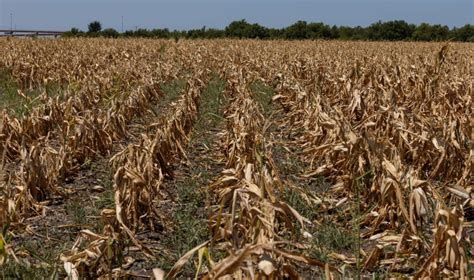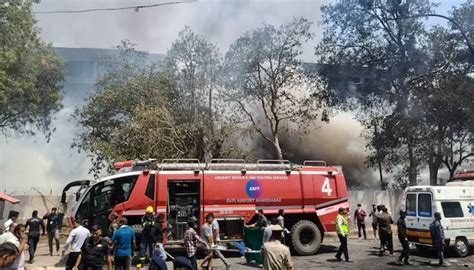
Record-breaking heatwaves are devastating crops across the United States, leaving farmers stunned and facing potentially catastrophic losses, with some stating they’ve “never seen this” level of devastation.
Across the Midwest and South, prolonged periods of extreme heat and drought conditions are scorching fields, decimating yields, and threatening the livelihoods of agricultural communities. Corn, soybeans, and livestock are among the hardest hit, sparking concerns about rising food prices and potential shortages. Farmers are reporting stunted growth, pollination failures, and significant losses of livestock due to heat stress, leading to a sense of despair and uncertainty about the future of their harvests. The severity of the current heatwave surpasses previous extreme weather events, according to several veteran farmers.
The unrelenting heat is exacerbating existing drought conditions in many agricultural regions. The U.S. Drought Monitor shows significant portions of the Midwest and South experiencing severe to extreme drought, further compounding the effects of the high temperatures. These dry conditions limit the availability of water for irrigation, leaving crops vulnerable to heat stress and hindering their ability to thrive. The combination of heat and drought is creating a perfect storm for agricultural disaster.
Soybean crops, a vital component of the U.S. agricultural economy, are particularly vulnerable during their critical reproductive stages. High temperatures can disrupt pollination and seed development, leading to reduced yields and lower quality beans. Farmers are reporting that even with irrigation, the extreme heat is overwhelming their efforts to keep the crops healthy and productive. The impact on soybean production could have ripple effects throughout the food industry, affecting prices for everything from cooking oil to animal feed.
Corn crops are facing similar challenges. The pollination process is highly sensitive to heat, and high temperatures can cause kernels to abort, resulting in ears with missing or underdeveloped kernels. This directly translates to lower yields and reduced profitability for corn farmers. The current heatwave is occurring during a crucial period for corn development, making the timing particularly damaging. Farmers are anxiously monitoring their fields, hoping for a break in the weather, but the long-term forecast offers little relief.
Livestock are also suffering under the extreme heat. Cattle, pigs, and poultry are all susceptible to heat stress, which can lead to reduced weight gain, decreased milk production, and even death. Farmers are implementing various strategies to mitigate the effects of the heat, such as providing shade, increasing ventilation, and offering cool water, but these measures can only do so much. The financial losses associated with livestock deaths and reduced productivity are adding to the already significant economic burden on farmers.
The impact of the heatwave extends beyond individual farms and threatens the broader agricultural economy. Reduced crop yields and livestock losses will likely lead to higher food prices for consumers. The agricultural sector is a major contributor to the U.S. economy, and a significant downturn in agricultural production could have far-reaching consequences. Economists are already beginning to assess the potential economic impact of the heatwave, and early estimates suggest that the losses could be substantial.
Federal and state agricultural agencies are working to provide assistance to farmers affected by the heatwave. Disaster relief programs, crop insurance, and technical assistance are available to help farmers cope with the immediate challenges and begin the recovery process. However, some farmers are questioning whether these programs are sufficient to address the scale of the crisis. They are calling for more comprehensive support, including long-term investments in drought resilience and climate adaptation.
The current heatwave is a stark reminder of the vulnerability of agriculture to extreme weather events. As climate change continues to drive more frequent and intense heatwaves, droughts, and other weather-related disasters, the agricultural sector will need to adapt to survive. This will require a combination of technological innovation, policy changes, and sustainable farming practices. Farmers, researchers, and policymakers must work together to develop strategies that can help agriculture withstand the challenges of a changing climate. The future of food security depends on it.
Many farmers highlight the emotional toll of witnessing their livelihoods wither before their eyes. The uncertainty and financial strain can be overwhelming, leading to increased stress and mental health challenges in rural communities. Support services and mental health resources are becoming increasingly important as farmers navigate these difficult times. The sense of community and shared experience can be a source of strength, but the need for professional help is also growing.
The long-term implications of the heatwave are still uncertain. It is possible that some crops will recover if the weather improves, but the damage done is already significant. The impact on future harvests will depend on factors such as soil moisture levels, pest and disease pressures, and the timing of future weather events. Farmers are facing a challenging and uncertain future, and the need for resilience and adaptation is more critical than ever. The stories of farmers struggling to cope with the extreme conditions highlight the urgent need for action to address climate change and support the agricultural sector.
The full extent of the financial damage will not be known until the harvest is complete. Crop insurance will help to offset some of the losses, but many farmers will still face significant financial hardship. The heatwave also threatens the viability of small family farms, which may lack the resources to weather such extreme events. The consolidation of agriculture could accelerate as smaller farms are forced to sell out to larger operations. This could have implications for rural communities and the diversity of the food system.
The heatwave underscores the interconnectedness of climate, agriculture, and food security. As the planet warms, extreme weather events are becoming more frequent and intense, posing a growing threat to agricultural production. Addressing climate change is essential to protecting the future of food security and ensuring that farmers can continue to provide the food that the world needs. This requires a global effort to reduce greenhouse gas emissions and transition to a more sustainable economy. It also requires investments in research and development to create climate-resilient crops and farming practices.
The immediate focus is on providing relief to farmers affected by the heatwave and helping them to recover from the losses. However, it is also important to learn from this experience and to develop strategies that can help agriculture better withstand future extreme weather events. This includes investing in drought-resistant crops, improving irrigation infrastructure, and promoting sustainable farming practices. It also includes developing policies that support farmers and encourage them to adopt climate-smart agriculture. The future of agriculture depends on our ability to adapt to a changing climate and build a more resilient food system.
One of the more pressing issues now involves the ability to accurately forecast these events. Weather models are constantly improving, yet farmers require precise, localized forecasts to make critical decisions about planting, irrigation, and harvesting. Enhanced investment in weather monitoring and forecasting technologies could prove invaluable in mitigating the impact of future extreme weather events. The development of early warning systems tailored to specific crops and regions could also help farmers prepare for and respond to impending threats.
The heatwave has also exposed vulnerabilities in the agricultural supply chain. Disruptions to crop production can have ripple effects throughout the entire food system, affecting processing, transportation, and distribution. Strengthening the resilience of the supply chain is essential to ensuring that food remains available and affordable in the face of climate-related disruptions. This includes diversifying supply sources, improving infrastructure, and developing more efficient logistics.
As the crisis unfolds, farmers are sharing their experiences and insights with each other, seeking advice and support. Online forums and social media groups have become important platforms for farmers to connect and share information. This collective effort to learn and adapt is a testament to the resilience and ingenuity of the agricultural community. However, the need for more formal channels of communication and knowledge sharing is also apparent. Agricultural extension services and research institutions can play a vital role in providing farmers with the information and resources they need to adapt to climate change.
The current crisis is not just an agricultural issue; it is a societal issue. The impacts of the heatwave will be felt by everyone, from farmers to consumers. Addressing the challenges requires a collaborative effort involving government, industry, research institutions, and the public. By working together, we can build a more resilient and sustainable food system that can withstand the challenges of a changing climate. The future of agriculture depends on our collective action.
Quotes from Farmers:
- “I’ve never seen anything like this,” said John Smith, a corn and soybean farmer in Iowa, whose crops are suffering from severe drought and heat stress.
- “We’re losing livestock every day,” lamented Mary Johnson, a cattle rancher in Texas, adding that the heat is pushing her animals to their breaking point.
- “It’s heartbreaking to watch your crops wither away,” expressed David Brown, a vegetable farmer in California, whose irrigation water supply is dwindling.
Frequently Asked Questions (FAQs):
-
What are the primary crops being affected by the current heatwave?
The primary crops being affected are corn and soybeans, but also livestock, and various vegetable crops are suffering. Corn and soybeans are crucial to the US agricultural economy, and their vulnerability during critical reproductive stages is particularly concerning. Livestock are also susceptible to heat stress, leading to reduced weight gain, decreased milk production, and even death.
-
What measures are farmers taking to mitigate the effects of the heatwave?
Farmers are implementing several strategies, including increasing irrigation where possible, providing shade for livestock, enhancing ventilation in animal housing, and offering cool water to livestock. Additionally, some are adjusting planting schedules for future crops and exploring drought-resistant varieties.
-
What kind of assistance is available for farmers affected by the heatwave?
Federal and state agricultural agencies are providing disaster relief programs, crop insurance, and technical assistance. These programs aim to help farmers cope with immediate challenges and begin the recovery process. However, some farmers are calling for more comprehensive support, including long-term investments in drought resilience and climate adaptation.
-
How might this heatwave affect food prices for consumers?
Reduced crop yields and livestock losses will likely lead to higher food prices for consumers. The agricultural sector is a major contributor to the U.S. economy, and a significant downturn in agricultural production could have far-reaching consequences, impacting the cost of various food products.
-
What are the long-term implications of these extreme weather events on agriculture?
The heatwave highlights the vulnerability of agriculture to extreme weather events exacerbated by climate change. Long-term, the agricultural sector will need to adapt through technological innovation, policy changes, and sustainable farming practices. This includes investing in drought-resistant crops, improving irrigation infrastructure, and promoting climate-smart agricultural practices to ensure food security in a changing climate.
Extended Article:
The relentless heatwave currently gripping the United States is not just a fleeting weather phenomenon; it’s a stark illustration of the escalating climate crisis and its profound impact on the nation’s agricultural heartland. Farmers, the stewards of the land, are facing unprecedented challenges as record-breaking temperatures and prolonged drought conditions decimate crops and threaten livestock, leaving them in a state of disbelief and uncertainty.
The Devastation Unveiled
From the vast cornfields of the Midwest to the sprawling soybean farms of the South, the story is the same: scorched fields, stunted growth, and yields far below expectations. The phrase “never seen this” echoes across rural communities, reflecting a shared sense of bewilderment and despair. Corn, soybeans, and livestock, the backbone of American agriculture, are bearing the brunt of the extreme weather, raising alarms about potential food shortages and price hikes.
The severity of the heatwave transcends previous extreme weather events, according to seasoned farmers who have weathered decades of climatic variability. The combination of intense heat and prolonged drought is creating a perfect storm, pushing crops and livestock beyond their limits. Even with advanced irrigation techniques, the sheer intensity of the heat is overwhelming, rendering many traditional mitigation strategies ineffective.
The Soybean Crisis
Soybeans, a vital commodity in the U.S. agricultural landscape, are particularly susceptible during their reproductive stages. High temperatures disrupt pollination and seed development, leading to shriveled beans and reduced yields. Farmers are investing heavily in irrigation, but the extreme heat is negating many of their efforts. The implications for the food industry are significant, as soybean production affects the prices of cooking oil, animal feed, and various processed foods.
The economic ramifications of a reduced soybean harvest are far-reaching. The U.S. is a major exporter of soybeans, and a decline in production could impact global markets, affecting food security and trade relationships. Domestic food manufacturers relying on soybeans as a key ingredient will face higher costs, which will likely be passed on to consumers.
The Corn Catastrophe
Corn crops are facing a similar plight. The pollination process is highly sensitive to heat, and high temperatures can cause kernels to abort, resulting in ears with missing or underdeveloped kernels. This directly translates to lower yields and reduced profitability for corn farmers. The timing of the heatwave is particularly damaging, as it coincides with a crucial period for corn development.
The consequences extend beyond the farm gate. Corn is a staple ingredient in animal feed, ethanol production, and various food products. A reduced corn harvest will drive up prices for these commodities, impacting industries and consumers alike. The ripple effect could be felt throughout the entire economy.
Livestock Under Stress
Livestock, including cattle, pigs, and poultry, are particularly vulnerable to heat stress. High temperatures can lead to reduced weight gain, decreased milk production, and even death. Farmers are implementing strategies to mitigate the effects, such as providing shade, increasing ventilation, and offering cool water, but these measures have limitations.
The financial losses associated with livestock deaths and reduced productivity are adding to the economic burden on farmers. The stress on animals can also impact the quality of meat and dairy products, potentially affecting consumer health and satisfaction. Animal welfare is also a major concern during extreme heat events.
Economic Fallout
The impact of the heatwave extends beyond individual farms and threatens the broader agricultural economy. Reduced crop yields and livestock losses will inevitably lead to higher food prices for consumers. The agricultural sector is a major contributor to the U.S. economy, and a significant downturn in agricultural production could have far-reaching consequences.
Economists are already assessing the potential economic impact of the heatwave, with early estimates suggesting substantial losses. The decline in agricultural output will impact related industries, such as transportation, processing, and retail. The overall economic slowdown could have cascading effects on employment and consumer spending.
Government Response
Federal and state agricultural agencies are working to provide assistance to farmers affected by the heatwave. Disaster relief programs, crop insurance, and technical assistance are available to help farmers cope with the immediate challenges and begin the recovery process. However, some farmers are questioning whether these programs are sufficient to address the scale of the crisis.
The adequacy of government support is a subject of debate. Some argue that existing programs are insufficient to compensate farmers for the full extent of their losses. Others call for more comprehensive measures, including long-term investments in drought resilience and climate adaptation.
The Human Toll
Beyond the economic impact, the heatwave is taking a significant toll on the mental and emotional well-being of farmers. Witnessing their livelihoods wither before their eyes is a source of immense stress and anxiety. The uncertainty and financial strain can lead to increased rates of depression and suicide in rural communities.
Support services and mental health resources are becoming increasingly important as farmers navigate these difficult times. The sense of community and shared experience can be a source of strength, but the need for professional help is also growing. Addressing the mental health crisis in rural areas is an essential part of the overall response to the heatwave.
Climate Change Connection
The current heatwave is a stark reminder of the vulnerability of agriculture to extreme weather events, which are becoming more frequent and intense due to climate change. The long-term implications for food security are profound. Addressing climate change is essential to protecting the future of food production.
Mitigation efforts, such as reducing greenhouse gas emissions, are crucial to slowing down the pace of climate change. Adaptation strategies, such as developing drought-resistant crops and improving irrigation infrastructure, are necessary to help agriculture withstand the challenges of a changing climate.
Adaptation and Innovation
As climate change continues to drive more frequent and intense heatwaves, droughts, and other weather-related disasters, the agricultural sector will need to adapt to survive. This will require a combination of technological innovation, policy changes, and sustainable farming practices.
Technological innovations, such as precision agriculture and vertical farming, can help to improve resource efficiency and reduce the environmental impact of agriculture. Policy changes, such as carbon pricing and subsidies for sustainable farming practices, can incentivize farmers to adopt climate-friendly approaches. Sustainable farming practices, such as crop rotation and no-till farming, can help to improve soil health and resilience to extreme weather.
Policy Implications
The heatwave underscores the need for comprehensive agricultural policies that support farmers in adapting to climate change. This includes investments in research and development, infrastructure improvements, and risk management tools.
Crop insurance programs need to be updated to reflect the changing climate risks. Disaster relief programs need to be more responsive and accessible. Policies that promote sustainable farming practices should be incentivized and supported.
Community Resilience
The response to the heatwave highlights the importance of community resilience. Farmers are sharing their experiences and insights with each other, seeking advice and support. Online forums and social media groups have become important platforms for farmers to connect and share information.
Strengthening community networks is essential to helping farmers cope with the challenges of climate change. Local organizations, such as agricultural extension services and farmer cooperatives, can play a vital role in providing information, resources, and support.
The Future of Food Security
The heatwave is a wake-up call about the fragility of the food system in the face of climate change. Ensuring food security in the future will require a concerted effort from governments, industry, and individuals.
Investing in climate-resilient agriculture is essential to protecting food production. Reducing food waste can help to conserve resources and reduce greenhouse gas emissions. Promoting sustainable diets can help to reduce the environmental impact of food consumption.
Specific Examples of Impact:
- In Iowa, cornfields are experiencing widespread pollination failures due to the intense heat, with some farmers estimating yield losses of up to 50%.
- Texas cattle ranchers are struggling to keep their livestock alive, with reports of significant cattle deaths due to heat stress.
- California vegetable farmers are facing severe water restrictions, forcing them to reduce their planted acreage.
- Illinois soybean farmers are reporting stunted growth and reduced bean size, leading to lower yields and reduced profitability.
Quotes from Farmers (Expanded):
- “I’ve been farming for over 40 years, and I’ve never seen anything like this,” said John Smith, a corn and soybean farmer in Iowa. “The heat is just relentless, and it’s killing my crops. I don’t know how I’m going to make a living this year.”
- “We’re losing livestock every day,” lamented Mary Johnson, a cattle rancher in Texas. “The heat is pushing my animals to their breaking point. It’s heartbreaking to watch them suffer.”
- “It’s heartbreaking to watch your crops wither away,” expressed David Brown, a vegetable farmer in California. “We’re facing severe water restrictions, and it’s impossible to keep everything irrigated. I’m afraid I’m going to lose everything.”
- “This is more than just a bad year; this is a sign of things to come,” said Susan Williams, a soybean farmer in Illinois. “Climate change is real, and it’s impacting my livelihood. We need to take action to address this crisis.”
Call to Action
The record heatwave wrecking US crops is a crisis that demands immediate attention and long-term solutions. Farmers are on the front lines of climate change, and they need our support to adapt to the changing climate and continue to provide the food that the world needs. By investing in climate-resilient agriculture, reducing food waste, and promoting sustainable diets, we can build a more secure and sustainable food system for the future. The time to act is now.
The agricultural community is resilient, but the scale of the challenge requires collective action. From consumers making informed choices about their food to policymakers implementing sustainable agricultural policies, everyone has a role to play in ensuring the future of food security. The current heatwave is a stark reminder of the interconnectedness of our climate, our food, and our future.
Frequently Asked Questions (FAQs – Expanded):
-
What are the primary crops being affected by the current heatwave, and what makes them particularly vulnerable?
The primary crops being affected are corn and soybeans, but also livestock, and various vegetable crops are suffering significant losses. Corn is vulnerable because the pollination process is highly sensitive to heat, which can cause kernels to abort, leading to lower yields. Soybeans are vulnerable during their reproductive stages, as high temperatures can disrupt pollination and seed development, resulting in reduced yields and lower quality beans. Livestock are susceptible to heat stress, which can lead to reduced weight gain, decreased milk production, and even death. Vegetable crops often require substantial irrigation, which is becoming more limited due to drought conditions.
-
What specific measures are farmers taking to mitigate the effects of the heatwave on their crops and livestock, and how effective are these measures proving to be?
Farmers are implementing several strategies, including:
- Increased Irrigation: Where water is available, farmers are irrigating more frequently to combat drought stress. However, water resources are dwindling in many regions.
- Providing Shade for Livestock: Farmers are using shade structures or moving livestock to shaded areas to reduce heat stress.
- Enhanced Ventilation: Farmers are improving ventilation in animal housing facilities to promote cooling.
- Cool Water Provision: Farmers are ensuring that livestock have access to cool, fresh water at all times.
- Adjusting Planting Schedules: Some farmers are adjusting planting schedules for future crops to avoid peak heat periods.
- Exploring Drought-Resistant Varieties: Farmers are considering planting drought-resistant crop varieties in the future.
While these measures provide some relief, their effectiveness is limited by the intensity and duration of the heatwave. In many cases, the extreme heat is overwhelming these mitigation efforts.
-
What kind of assistance is available for farmers affected by the heatwave, both from government and private sources, and what are the eligibility requirements for these programs?
Federal and state agricultural agencies are providing:
- Disaster Relief Programs: These programs offer financial assistance to farmers who have suffered significant losses due to the heatwave.
- Crop Insurance: Farmers who have crop insurance can file claims to recover some of their losses.
- Technical Assistance: Agricultural extension services provide technical advice and support to farmers.
Eligibility requirements for these programs vary. Farmers typically need to demonstrate significant losses and meet certain income and production requirements. Private sources of assistance may include loans, grants, and charitable donations.
-
How might this heatwave affect food prices for consumers, both in the short term and the long term, and what specific food products are likely to be most affected?
Reduced crop yields and livestock losses will likely lead to higher food prices for consumers, both in the short term and the long term. Specific food products likely to be most affected include:
- Corn-based products: Cornmeal, corn syrup, animal feed.
- Soybean-based products: Cooking oil, animal feed, soy milk, tofu.
- Meat and dairy products: Beef, pork, poultry, milk, cheese.
- Vegetables: Prices of certain vegetables may increase due to reduced yields and higher irrigation costs.
-
What are the long-term implications of these extreme weather events on agriculture and food security, and what steps can be taken to build a more resilient and sustainable agricultural system?
The long-term implications include:
- Increased Frequency of Extreme Weather Events: Climate change is expected to increase the frequency and intensity of heatwaves, droughts, and other extreme weather events, posing a growing threat to agriculture.
- Reduced Crop Yields: Extreme weather events can significantly reduce crop yields, leading to food shortages and higher prices.
- Increased Water Scarcity: Droughts can exacerbate water scarcity, making it more difficult for farmers to irrigate their crops.
- Economic Instability: Extreme weather events can cause economic instability in agricultural regions, leading to job losses and business closures.
Steps to build a more resilient and sustainable agricultural system include:
- Investing in Drought-Resistant Crops: Developing and planting drought-resistant crop varieties can help to reduce the impact of droughts on crop yields.
- Improving Irrigation Infrastructure: Improving irrigation infrastructure can help to conserve water and ensure that farmers have access to the water they need.
- Promoting Climate-Smart Agricultural Practices: Promoting climate-smart agricultural practices, such as crop rotation, no-till farming, and cover cropping, can help to improve soil health and resilience to extreme weather.
- Supporting Farmers: Providing farmers with financial assistance, technical assistance, and access to risk management tools can help them to adapt to climate change.
- Reducing Greenhouse Gas Emissions: Reducing greenhouse gas emissions is essential to mitigating climate change and reducing the frequency and intensity of extreme weather events.
- Improved forecasting and early warning systems: Investing in better weather models and local predictions can help farmers make informed decisions.
- Diversifying the food supply: Relying on a variety of crops and geographic regions can buffer against localized disasters.
The urgency of the situation demands a comprehensive and collaborative approach to ensure the long-term viability of US agriculture and the stability of the nation’s food supply. The experiences of farmers during this heatwave serve as a critical lesson in the interconnectedness of climate, agriculture, and the well-being of communities across the country.









